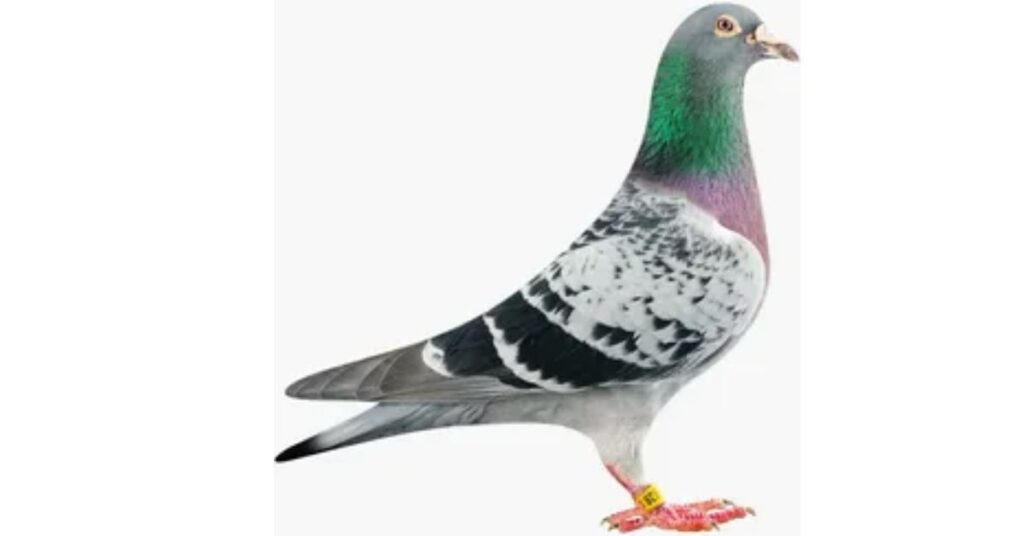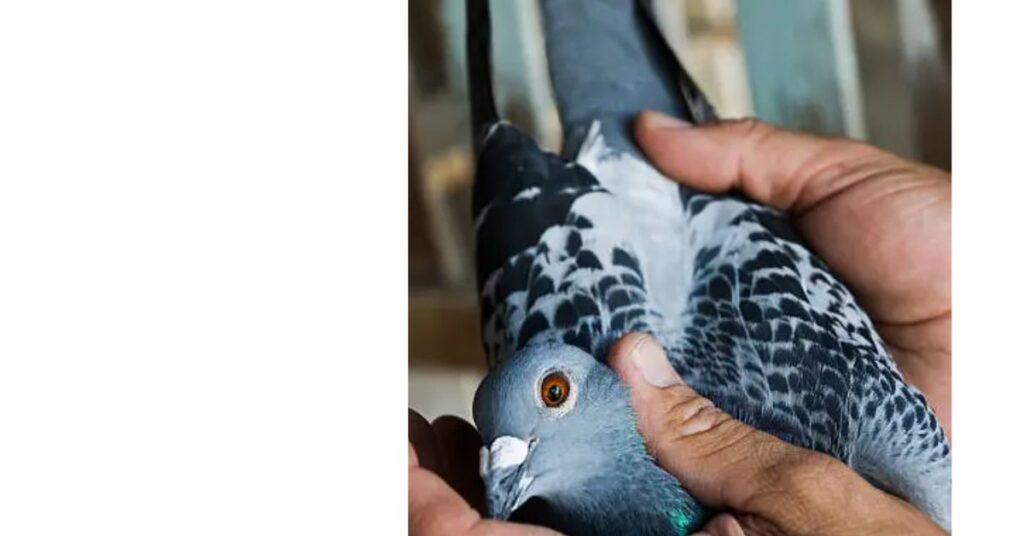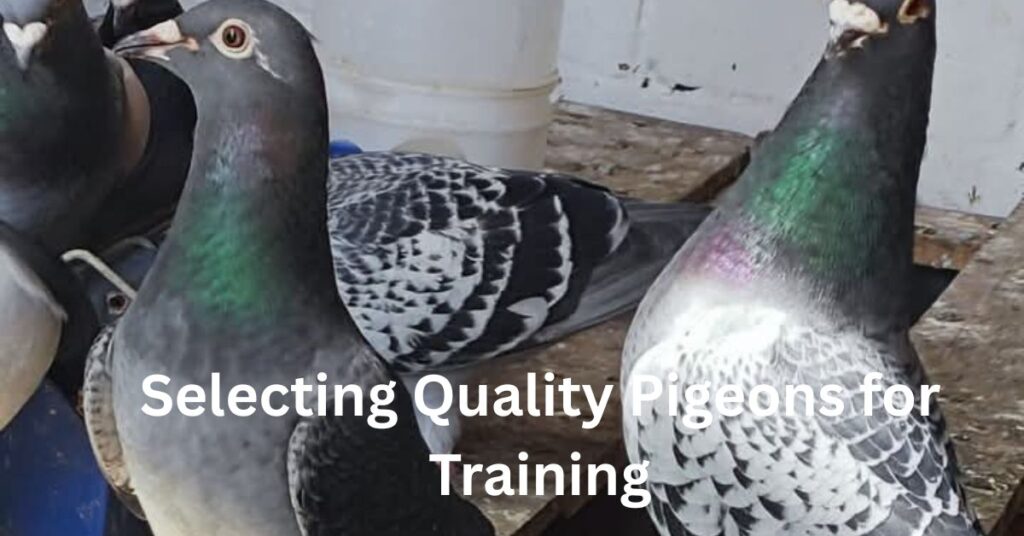If you’re thinking about getting into pigeon racing or even just enjoying the art of free-flying pigeons, the most important place to start is with selecting quality pigeons for training.
But what exactly makes a pigeon “quality”? Is it just about bloodline? Or is there more to it?
In this article, we’ll break down every step in selecting quality pigeons for training, share real-life anecdotes, and offer a guide you can trust whether you’re a beginner or looking to improve your loft.
🕊️ Selecting Quality Pigeons for Piering: Why the Right Pigeon Matters

You wouldn’t enter a car race with a vehicle that wasn’t built to compete, right? The same logic applies to pigeon racing. Even if you feed them the best diet or invest in top-tier training, a pigeon without the right genetics and structure won’t fly its best.
Performance in flight starts before the bird even hatches, and that’s why selecting a quality pigeon is step one in your success story.
📌 Step 1: Selecting Quality Pigeons for Training with a Good Genetic Background
One of the key phrases you’ll often hear in the world of pigeon enthusiasts is:
“The chances of breeding a winner are increased when it is bred from a winner.”
And it’s true.
When you’re picking pigeons, look for those with a strong bloodline. This doesn’t just mean the parents raced—they must have performed well in actual competitions. Look for birds descended from top-performing lines such as the Janssen brothers’ pigeons, which are world-famous for their racing ability.
✅ Quick Tip:
Ask for race records, parentage, and health history before buying. A serious breeder will always share this.
🔍 Step 2: Selecting Quality Pigeons with the Best Physical Traits

Sometimes, you’re unable to access birds from famous bloodlines. Don’t worry—there’s still hope! You can evaluate the physical features of a pigeon to get a pretty good idea of its potential.
Here’s what to look for in a physically sound pigeon:
- Bright, moist, and alert eyes – This indicates good health and attentiveness.
- Feathers – Should be soft, fine, and shiny. This improves aerodynamics.
- Tail – Short and tightly held. A fanned or droopy tail suggests weakness.
- Chest – Broad and strong, ideal for endurance.
- Muscle tone – Feel for firmness and elasticity.
- Feet and claws – Strong red claws and straight toes are essential for balance.
- Body balance – Should feel solid and symmetrical in your hand.
🧠 Anecdote: A friend of mine once bought a pigeon purely based on color—a beautiful silver-gray. It had no strength in its wings and lacked focus. It never returned from its second training flight. That experience taught us: beauty is not always quality.
🧬 Step 3: Selecting Quality Pigeons for Training by Assessing Health and Immunity
A strong immune system means better recovery after training, less risk of illness, and long-term endurance.
What to Inspect:
- Complete feathers, no bald patches.
- Quick reaction to movement and sound.
- No visible illness, such as discharge, sluggishness, or labored breathing.
Be wary of any bird that seems lazy, old, or disconnected from the flock. These are signs of potential problems.
✋ Step 4: Selecting Quality Pigeons by Handling and Evaluation
Once you’ve spotted a potential candidate, pick it up gently and evaluate these features:
- Muscle softness – Should feel like a firm peach, not too hard or too loose.
- Eye symmetry – Look for clear and identical pupils with a distinct center dot.
- Feet proportion – Ideally, the feet should be around 0.5–1 inch shorter than the leg.
- Wing structure – Spread the wing gently; feathers should align cleanly.
💡 Pro Tip: Spend time watching how the pigeon moves in the loft. Is it confident? Does it interact well with others? Observing behavior can be as telling as physical examination.
❌ Step 5: Avoid Common Mistakes When Selecting Quality Pigeons for Training
Here’s a short list of what not to do:
- ❌ Buying pigeons without knowing their bloodlines or past performance
- ❌ Choosing solely based on color or appearance
- ❌ Ignoring age, health, or breed purpose
Remember: a beautiful bird isn’t always a racer.
Step 6: Selecting Quality Pigeons of the Right Age
Age is more important than most people think.
| Purpose | Ideal Age |
| Loft training | 5 to 8 weeks old |
| Race training | 1 to 4 years old |
| Breeding only | 4+ years (if still healthy) |
Older pigeons can still be valuable, especially for breeding quality offspring, but should not be pushed into flying or racing roles.
Step 7: Selecting Quality Pigeons Through Personal Connection
Let’s talk heart-to-heart for a moment.
In a world where mass breeding and big teams are common, it’s easy to forget that pigeons are living beings. Many experienced fanciers have noted that personal care and individual attention go a long way in developing winning birds.
True Story: One passionate breeder shared how he started with just 9 pigeons. He could name everyone, knew their personalities, and trained them individually. His belief? That individual love, care, and time put into each bird is what truly develops its racing potential, not just genes or numbers.
He even said:
“To me, the loyalty and love of a pigeon can be determined not by how fast it flies, but whether it chooses to come back to you.”
And isn’t that beautiful?
🧠 Step 8: Selecting Quality Breeding Pigeons Based on Training Goals
If you’re going to breed your own training pigeons, it’s crucial to pair birds that match your flight objective.
For Racing:
- Pair fast flyers from proven bloodlines.
- Look for lean, muscular, and aerodynamic features.
For High-Flying Shows:
- Select endurance birds that can tolerate heat and long durations in the sky.
Make sure both male and female birds are:
- Healthy
- From compatible families
- Aerodynamically suite
🏆 Step 9: Selecting Quality Pigeons from Reputable Breeders

Your best bet is to buy from someone you trust—a mentor, a known fancier, or a breeder with proven pigeons.
If you’re going to the market:
- Take someone experienced with you.
- Do not rush your decision.
- Spend time observing the breeder’s loft—it tells you a lot about their methods.
Here’s how to spot a trustworthy pigeon breeder.
✅ Quick Reference: Selecting Quality Training Pigeons
Use this checklist to guide your choices and ensure you’re building a strong foundation for your loft:
| Selection Criteria | What to Look For |
| Bloodline | Descended from race-winning birds with verifiable performance records |
| Physical Structure | Strong chest, tight tail, soft shiny feathers, muscular body, symmetrical build |
| Health & Alertness | Bright eyes, quick response, clean feathers, no signs of illness or weakness |
| Age Suitability | 5–8 weeks for loft training, 1–4 years for racing, 4+ years for healthy breeding |
| Breeder Reputation | Trusted, transparent, and knowledgeable with a clean, well-managed loft |
| Behavior | Confident, social, curious, and active in the loft |
| Breeding Pair Matching | Birds selected based on flight goals (racing vs. endurance vs. show flying) |
| Emotional Connection | A bird you feel confident and connected to—loyalty matters in training |
| Common Pitfalls to Avoid | Choosing by looks alone, ignoring lineage, or skipping health checks |
❓ Frequently Asked Questions
Q: How do you know if a pigeon is good quality?
A good quality pigeon has strong genetics, a well-balanced body, sharp alertness, healthy feathers, and shows strong homing instincts.
Q: How to select a good racing pigeon?
Select racing pigeons from proven bloodlines with race records, strong physical traits, excellent wing structure, and responsive, alert behavior.
Q: What makes a good pigeon?
A good pigeon combines health, temperament, physical fitness, and loyalty, shaped by both genetics and personal care from the handler.
Q: What are the characteristics of a good racing pigeon?
Key characteristics include a streamlined body, soft feathering, high endurance, keen orientation, and a strong drive to return home.

